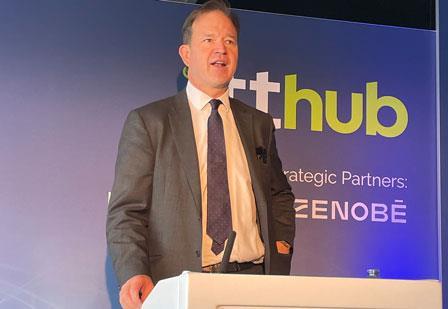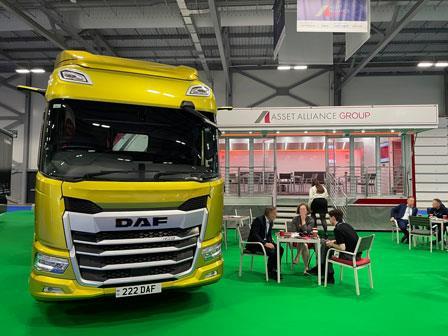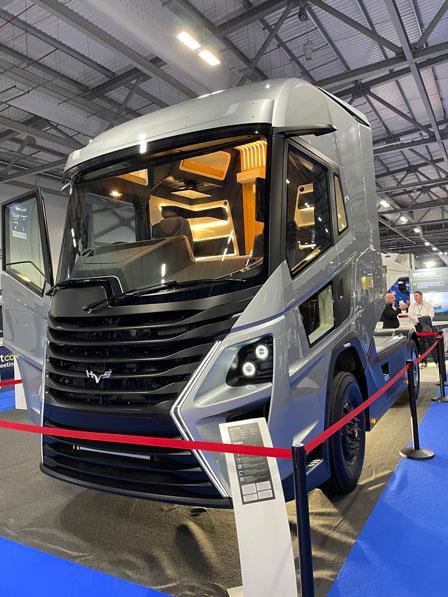
Speaking exclusively to MT after his address to the Logistics UK Future Logistics conference, transport minister responsible for decarbonisation Jesse Norman MP did not rule out increasing the 44-tonne maximum weight limit for zero emissions HGVs to compensate for the additional weight of alternative drive trains.
The DfT has just ended the 11-year trial of longer semi-trailers (LSTs) allowing any operator run 15.65m trailers and is bringing in regulations allowing zero-emissions commercial vehicles to run 2 tonnes heavier than conventional vans and trucks – though not for maximum weight vehicles.
RHA technical director Paul Allera has called for the 44-tonne maximum GVW to be reviewed to allow maximum use of the extra volume and Malcolm Group chief executive Andrew Malcolm has proposed trucks being allowed to run at 48 tonnes within 48 miles of container terminals to encourage take up of intermodal freight.
“The industry’s desire to increase gross vehicle weights is well known,” said Norman. “We will consider all these suggestions and I have no doubt the team is already engaging with the sector on this.”
Logistics UK has also called for the use low carbon fuels to be incentivised through the fuel duty regime to recognise their role in reducing carbon emissions now and into the future.
“There are plenty of different uses for biofuels and they don’t all have the same decarbonisation benefits,” responded Norman. “Biofuels themselves generate emissions including NOx and some carbon so they are not a zero-emission fuel. There are areas where they may have some role as part of a transition process and that is why we have been supportive of them in many different ways.
“But we are not planning to change the rules on zero-emissions vehicles as they are currently framed.”
While the DfT is making a plug-in truck grant of up to £25,000 available until March 2025 many observers believe this will not bridge the affordability gap between diesel and electric vehicles for the vast majority of small to medium sized operators.

“There are some zero-emissions technologies that are already commercially viable including retrofit technologies and others like hydrogen fuel cells which are still developing,” said Norman. “We are not at the point yet where any of these trade-offs are going to be felt and we wouldn’t expect that point until we get much closer to the 2035 and 2040 cut-off dates.
“By then I would expect three things to have happened. One is technology will continue to escalate and that will drive prices down. Second the financing options that already exist will be even more elaborate than they are now and zero-emissions vehicles are cheaper to run even though the upfront capital cost is more. Finally we will be in the situation we are in now in the car sector where there is a flourishing secondhand market.
“All those will create affordable options for people though it is not necessarily easy to see them now.”
When it comes to HGVs it is not yet clear whether battery electric or hydrogen will be the preferred method of propulsion, but the choice may be swayed by government policy on how it will decarbonise the wider economy. If for example green hydrogen becomes widely available through the national gas grid that would make it a far more attractive road fuel than if it had to be made locally.
“It is completely understandable for everyone to say ‘can we just plump so we get some clarity’,” said Norman. “But that would be a mistake. At this early stage technology is moving so quickly and commercial models are still developing. It is mad to do anything other than take a broad spectrum approach and that is what we are doing.
“Do we within government cooperate and talk about the big picture that is emerging between transport, housing and industrial users? Absolutely. One of the felicitous aspects of my own career is that I went from being energy minister to being roads minister to being in charge of the tax system to my current brief of decarbonisation. I couldn’t have designed a career that gave me more experience in the different areas.
“Because of the nature of the energy intensity of different industries there will be different needs for energy. The hydrogen hub we are setting up in the Tees Valley is a reflection of a particular need that area has for lots of energy and we think that is a great place to do the testing. If that is successful it may be that the use of hydrogen would expand to other areas on the back of that hub.
“But we won’t get much investment in hydrogen in some of our rural areas as they will have different needs.”
If battery electric is to be truly zero emissions the government also has to take steps to make the national electricity grid 100% powered from renewable sources like wind which is bedevilled by its intermittency. One option for base load low or no carbon generation is nuclear energy - but this remains a controversial option.

“There is a political argument about how far nuclear energy is a genuinely green technology,” said Norman. “The government view is that, while there are hydrocarbon costs to creating it, it is a very green energy source over time. It is essential to have a base energy supply to sit alongside our renewables.
“When I was at BEIS [the Department for Business, Energy and Industrial Strategy] many years ago we launched all the offshore renewables and the expectation then was that the early prices might be high but they would fall over time. We are now not far away from subsidy-free offshore wind but its intermittency means we will need a variety of other base energy sources such as nuclear.
“With the increasing use of batteries our goal is that there will be no intermittency support from internal combustion engines so that is a good hard budget constraint. We need to think very hard about how that combination of zero-emission fuels, electrification, batteries and nuclear can be part of the energy mix.”
Even with unlimited sources of renewable electricity, getting the power from the grid into vehicle batteries remains a major obstacle to decarbonising fleet operations. Upgrading electricity connections to enable depot-based charging is expensive and slow. While the government has allocated £1bn to Project Rapid to help build a national rapid charging network that money will not be made available to fleet operators.
“Infrastructure is a serious issue,” admitted Norman. “As a minister I am very hands-on so I am always asking ‘what is going on, what are you doing, send me the timetable’. In the case of Rapid that means quite a complicated two-step where we have to bring in the network operators and the charge point operators into the same place.
“That is happening but not as fast as I would like and there is variable performance in different areas. There will be specific blockages where through regulation, coordination or occasionally subsidy government can have an important role.”














